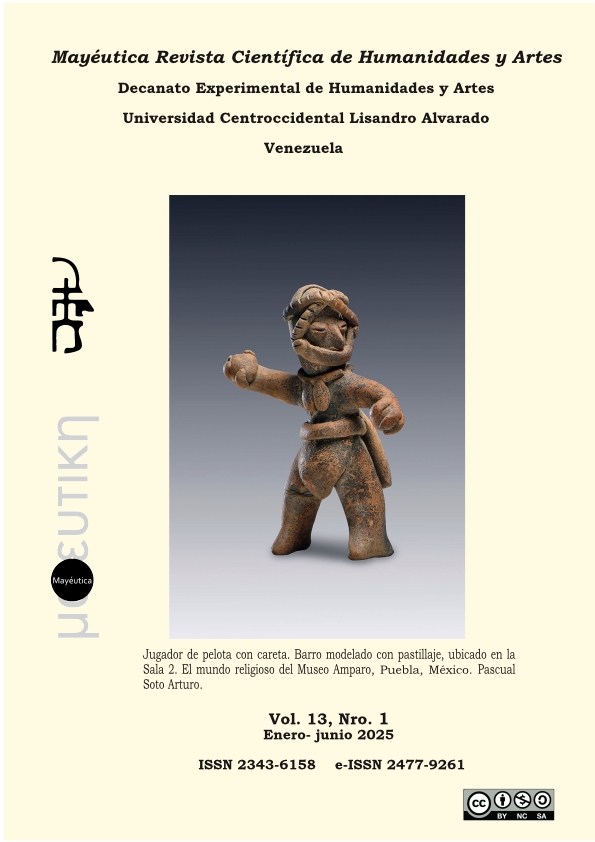The artwork in the age of environmental collapse: frictions, paradoxes and bifurcations
DOI:
https://doi.org/10.5281/zenodo.14548009Keywords:
Biotech and Environmental Art, Techné, Composting with care, Epistemic diversity, frictions, bifurcationAbstract
This paper examines some paradoxes present in environmentally engaged art practices, language, and storytelling, exploring possible bifurcations capable
of challenging current hegemonic worldviews. Using the concept of compostingwithcare, we critique the anthropocentrism inherent in narratives incorporated into art discourses such as sustainability and, by examining transdisciplinary intersections between the body and techne in art, offer alternatives. With a focus in biotechno and environmental art, the paper interrogates whether art can move beyond aura and denunciation and suggests that to enable alternative visions of the Anthropocene and inspire systemic change, art needs to incorporate ethics and morethanhuman perspectives into its practice by engaging with local communities and fostering a sense of care, responsibility, and reciprocity. Going beyond aesthetic gestures of environmentalism, artistic praxis must foster an intersectional relationality that cares for epistemological diversity; for example, an artistic praxis model with a long history in the translocal artistic networks of Latin America. Contrary to “sustainability”, this model seeks a plethora of bifurcations to bring about a pluralistic paradigm change. By situating artworks as points of intersection between actors in a mesh, artistic praxis may be understood as negentropic in its generation of multiscalar diversity and cobecomings and thus curative of the trappings of algorithmic governance. We argue for an art that cares for relations between different actors: human and morethanhuman, that cares for difference and that generates the frictions needed to effect change. An art that cares and also understands the importance of letting things be without human intervention.
Downloads
References
Alys, F. (1997). Paradox of Praxis 1 (Sometimes Making Something Leads to Nothing). https://www.tate.org.uk/whatson/tatemodern/francisalys
Benjamin, W. (1969). Illuminations. Schocken Books.
Braidotti, R. (2019). A Theoretical Framework for the Critical Posthumanities. Theory, Culture & Society. 36 (6), 31-61.
Braidotti, R. (2022). Feminismo Posthumano (TRL). Gedisa.
Camnitzer, L. (2007). Conceptualism in Latin American Art: Didactics of Liberation. The University of Texas Press.
Centro de Arte y Comunicación. (1971). Joseph Kosuth. El arte como idea. GT-48. Centro de Arte y Comunicación.
Centro de Arte y Comunicación. (1974). Arte de sistemas en Latinoamérica, no. GT-429. Centro de Arte y Comunicación.
Clark, B. (2008). Posthuman Metamorphosis: Narrative and Systems. Fordham University Press.
Clark, L. & Bois, Y. (1994).Nostalgia of the Body. October 69. 85-109.
Colebrook, C. (2014). Death of the Posthuman. Essays on Extinction. Vol 1. Open Humanities.
Colebrook, C. (2014, 2 de noviembre). We have always been PostAnthropocene. Lecture at the University of Pittsburgh. Synthetic Zero. https://syntheticzero.net/
/11/02/clairecolebrooksanthropocenecounterfactual/
Derrida, J. (1974). Of grammatology. The Johns Hopkins University Press.
Derrida, J. (1981). Dissemination. University of Chicago Press.
Despret, V. (2016). What Would Animals Say if We Asked the Right Questions? University of Minnesota Press.
Despret, V. (2021). Autobiographie d’ un Poulpe. Et autres récits d’ anticipation. Mondes Sauvages, Actes Sud.
Eliasson, O. (2014). Ice Watch. Artwork • Studio Olafur Eliasson Ice Watch.
Escrivá, J. (2023). Contra la Sostenibilitat. Sembra Llibres.
Esparza, G. (2021). Koralysis. Proyectos. https://gilbertoesparza.net/proyectos/
Glusberg, J., Centro de Arte y Comunicación. (1972) Hacia un perfil del Arte latinoamericano. No. GT-129. Centro de Arte y Comunicación.
González Sánchez, J. (2 de mayo de 2018). Bettina Cruz: Eólicas españolas desplazan a indígenas en México. Espacio Mex. https://espaciomex.com/
historias-mextraordinarias/bettina-cruz-eolicas-espanolas-desplazan-a-indigenas-en-mexico/
Gramsci, A. (1971). Selections from the Prison Notebooks. International Publishers.
Grewal. A. (2019). A Critique of Land Art as ‘Sustainable’ Environmental. Art Online Journal of Multidisciplinary Subjects. 13 (1). https://www.academia.edu/41221606/A_Critique_of_Land_Art_as_a_Sustainable_Environmental_Art
Hamilton, J. M. & Neimanis, A. (2018) Composting feminisms and environmental humanities. Environmental Humanities. 10 (2), 501–527.
Haraway, D. J. (1996). Staying with the Trouble: Making Kin in the Chthulucene. Duke University Press.
Hierro, L. (2 de noviembre de 2017). Ellas Heredarán la Tierra. El País Online. https://elpais.com/elpais/2017/10/17/planeta_futuro/1508257291_357885.html
hooks, b. (2000). Feminism is for everybody: Passionate politics. Cambridge. South End Press.
Hui, Y. (2016). The Question Concerning Technology in China: An Essay in Cosmotechnics. Urbanomic Media.
Laclau, E. & C. Mouffe. (2001). Hegemony and Socialist Strategy. Verso.
León, J. C. (2018). Tiempo Natural. Gráficas Hernández.
Mackinnon, L. (2016). Love’s Algorithm: The Perfect Parts For My Machine. lgorithmic Life: Calculative Devices in the Age of Big Data. (Amoore, Louise and Volha Piotukh, eds). Routledge.
Marchán Fiz, S. (1972). Del arte objetual al arte de concepto. Akal.
Margulis, L. (1967). On the origin of mitosing cells. Journal of Theoretical Biology. 14 (3), 225–274. DOI:10.1016/0022-51936790079-3
Morton, T. (2007). Ecology without Nature. Cambridge, Mass, Harvard University Press.
Plante, I. (2014). Between Paris and the “Third World: Lea Lublin’s Long 1960s. Artl@s Bulletin. 3 (2): Article 4.
Puig de la Bellacasa, M. (2017). Matters of Care: Speculative Ethics in More Than Human Worlds. University of Minneapolis Press.
Ramírez, J. (2019). Inversión en energías eólicas en el Istmo de Tehuantepec–continuidad del colonialismo interno en las disputas territoriales. Iberoamericana. 40-52.
Richard, N. (2022). Desajustar el marco del feminismo: una lectura de Judith Butler desde el Sur. Representations. 158 (1): 77-86.
Santos, T. (19 de febrero de 2018). La ‘mujer que no sabe’ se rebeló contra el maltrato. El País. https://elpais.com/elpais/2018/02/01/planeta_futuro/1517501170_389034.html?
id_externo_rsoc=FB_MX_CM&id_externo_rsoc=TW_AM_CM
Stiegler, B. (1998). Technics and Time: The Fault of Epimetheus. (Vol. 1). Stanford University Press.
Stiegler, B. (2019). The Age of Disruption. Technology and Madness in Computational Capitalism. Polity Press.
ToribioRoura, E., McDonald, S. y O’Sullivan, J. (2024). The Fable of the Cyclops and the Mantis Shrimp. Composting with Care for Epistemic Diversity. Technē
Logos, Care and the (Neg) Anthropocene. (Fitzpatrick, N. y Vaughan, C. Eds). DOI:10.21427/hz2wf370
Tsing, A. (2017). The Buck, The Bull and the Dream of the Stag: Some Unexpected Weeds of the Anthropocene. Suomen Antropologi. 42(1), 3-21.
Zylinska, J. (2014). Minimal Ethics for the Anthropocene. Open Humanities Press.
Zylinska, J. (2017). NonHuman Photography. https://www.nonhuman.photography/introduction
Published
How to Cite
Issue
Section

This work is licensed under a Creative Commons Attribution-NonCommercial-ShareAlike 4.0 International License.





